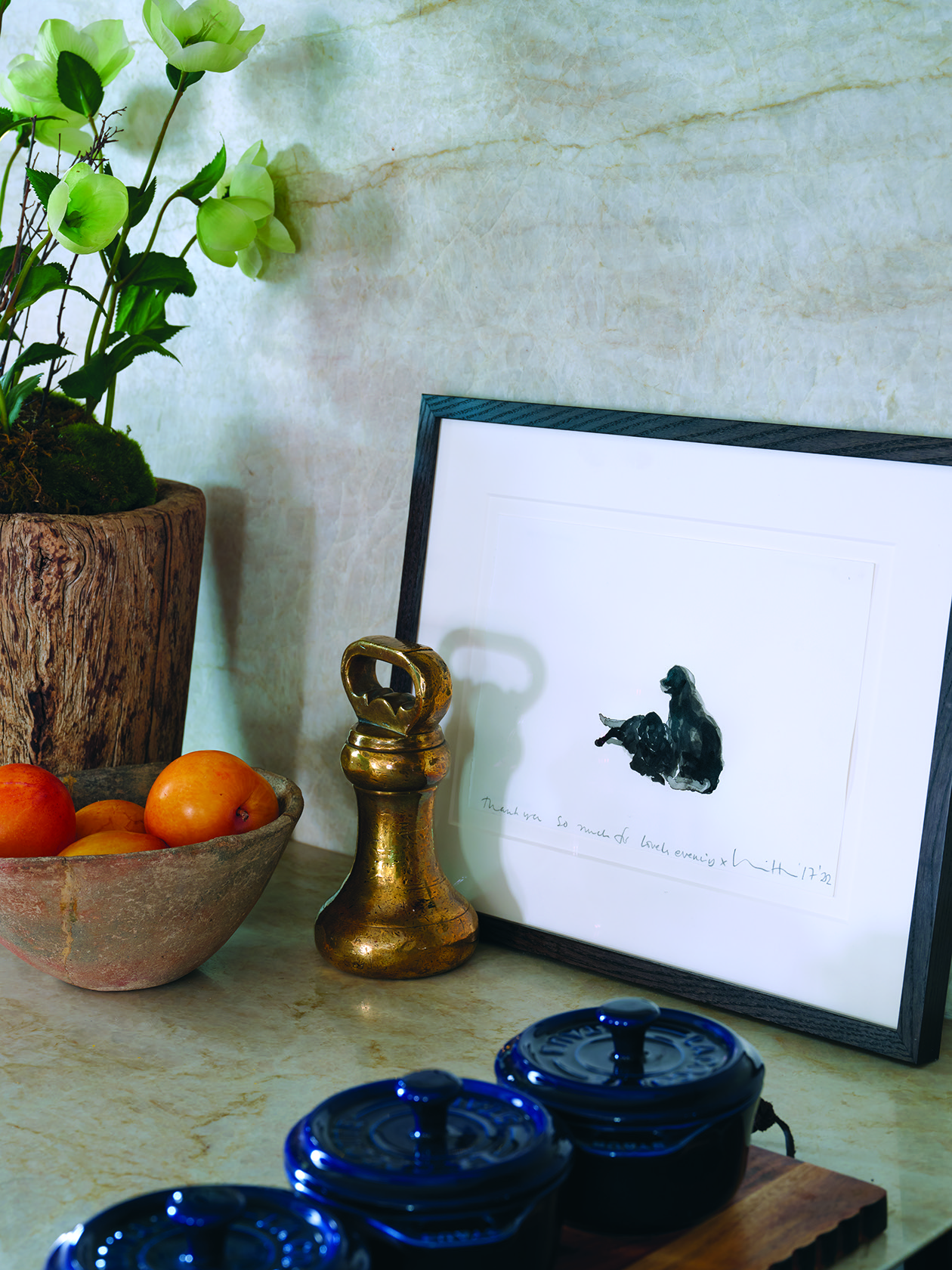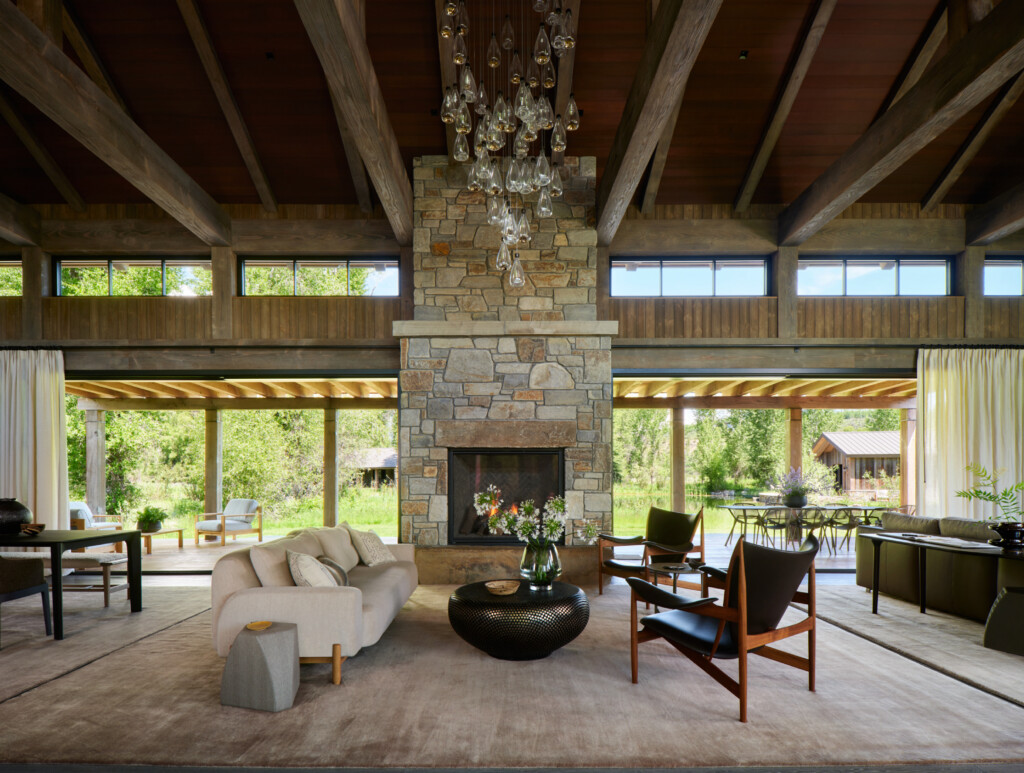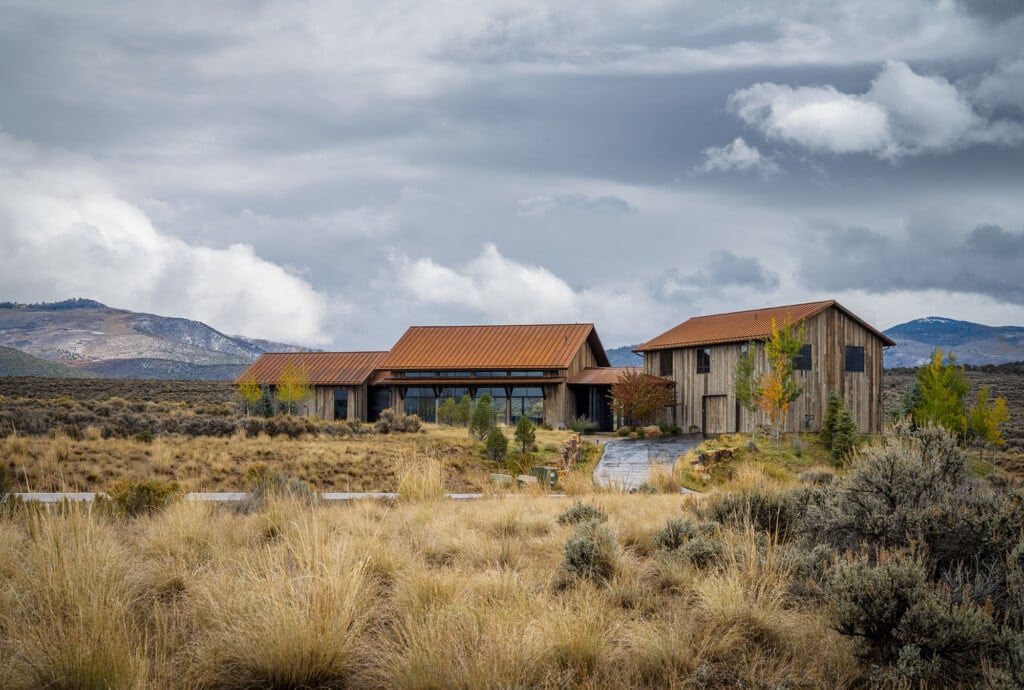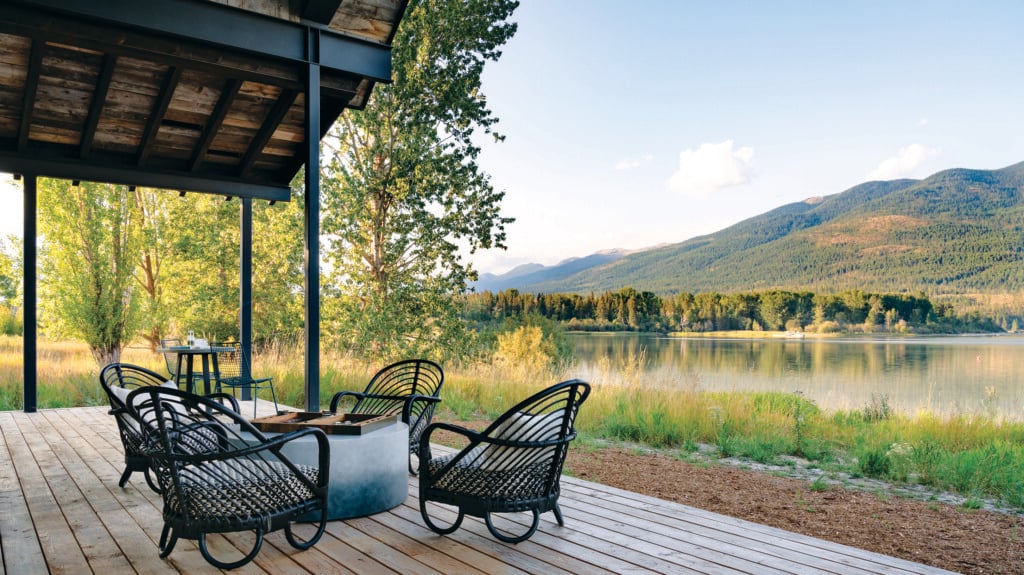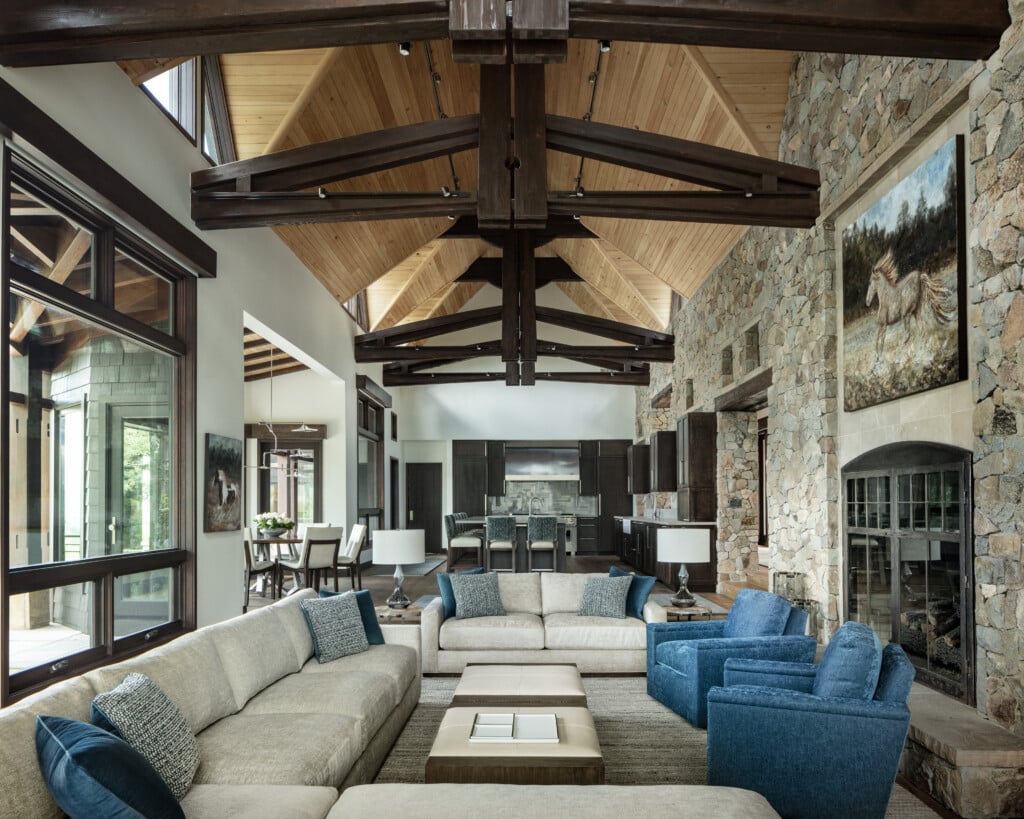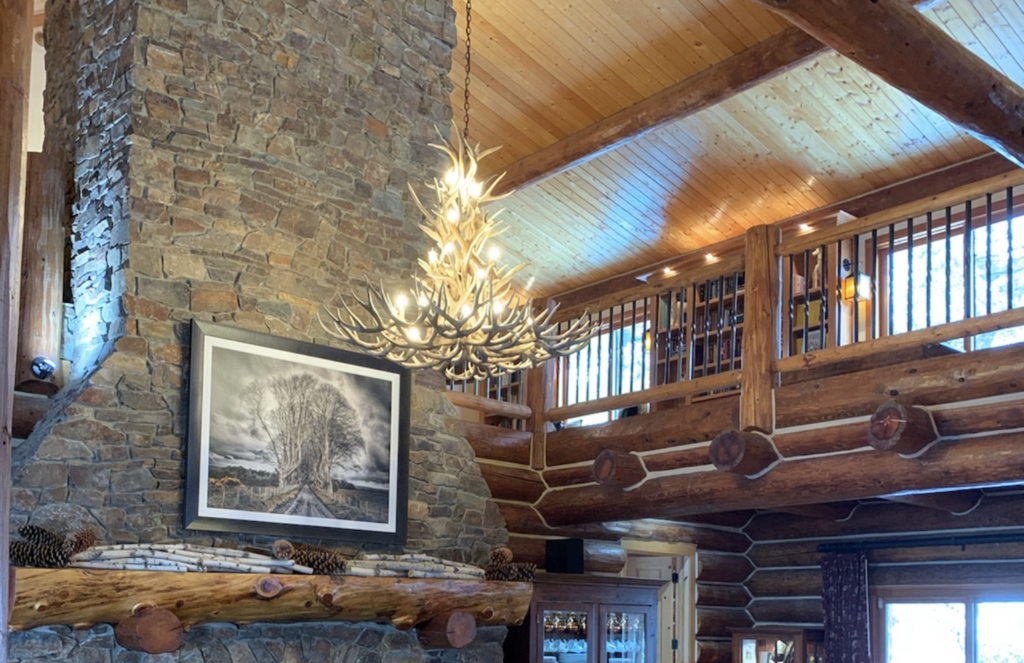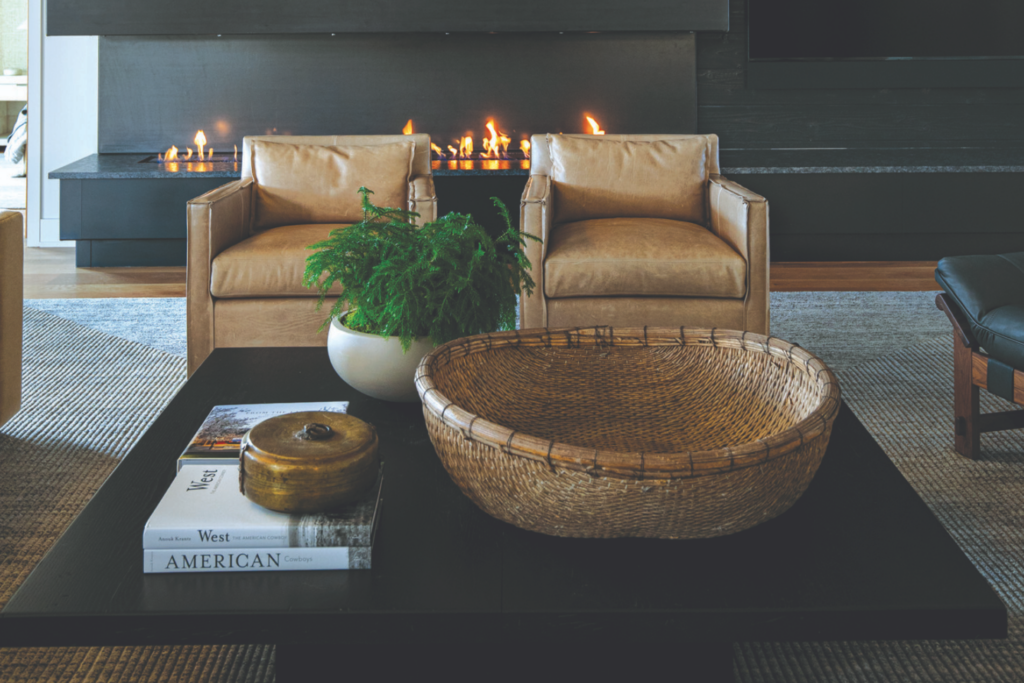WRJ Co-Founders Open the Doors to their 1950s Jackson Bungalow for an Exclusive Look Inside
The owners of WRJ Design share their Jackson home
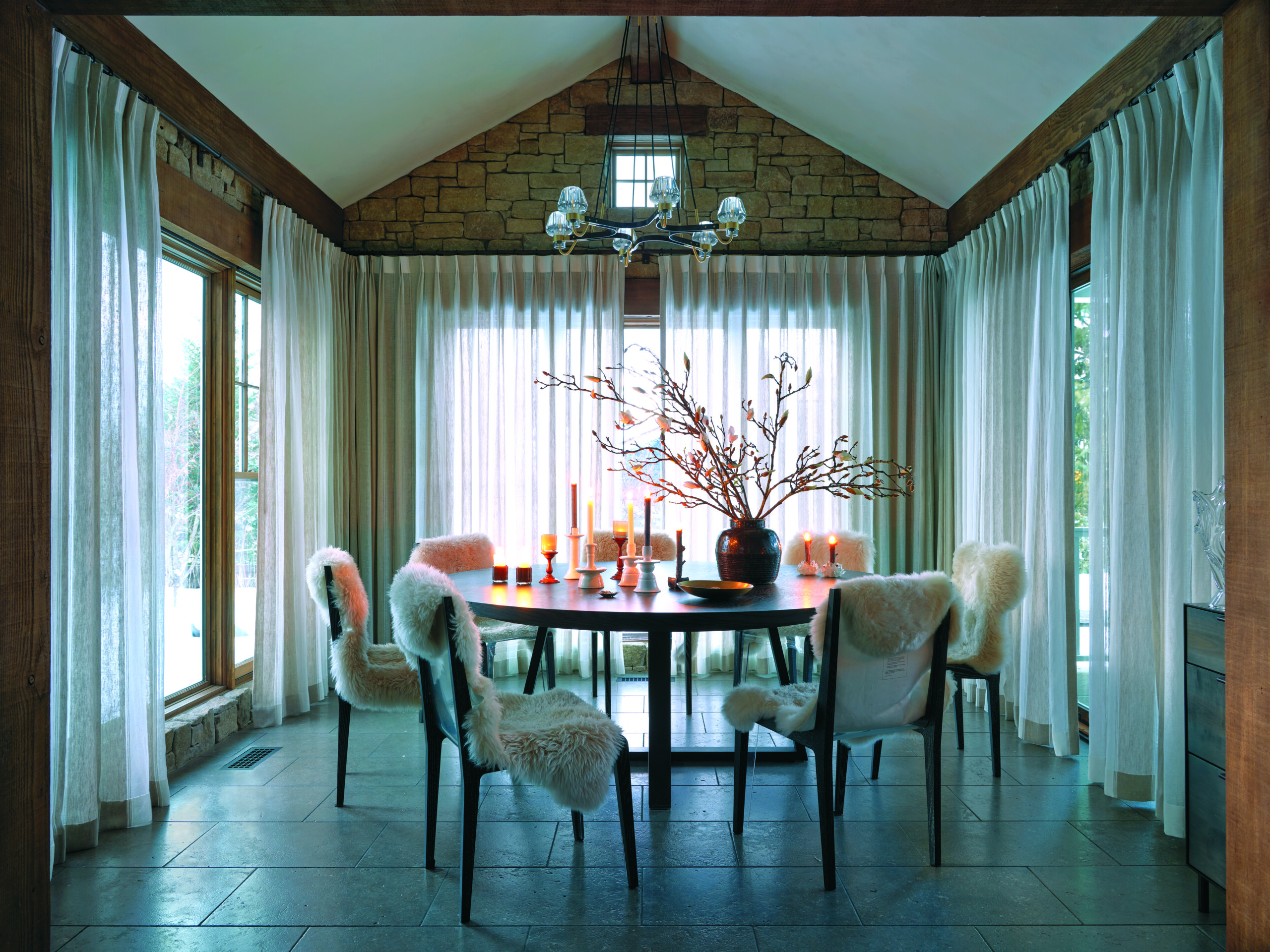
1/9: WRJ Design’s Rush Jenkins and Klaus Baer’s dining room combines stone and reclaimed beams with windows on three sides. “We love this room so much because it really connects to nature,” says Jenkins. Jonathan Browning chandelier, Loro Piana sheers, cozy shearling throws and a round table to promote conversation. | Photo Roger Davies
Jackson, Wyoming, may not seem the most logical destination for New Yorkers with international backgrounds, but for Rush Jenkins and Klaus Baer it was in their blood. And the home they’ve created there reflects that. It is both modest and sophisticated, simple yet richly layered, of the West and of the world, and a perfect balance of persona and place.
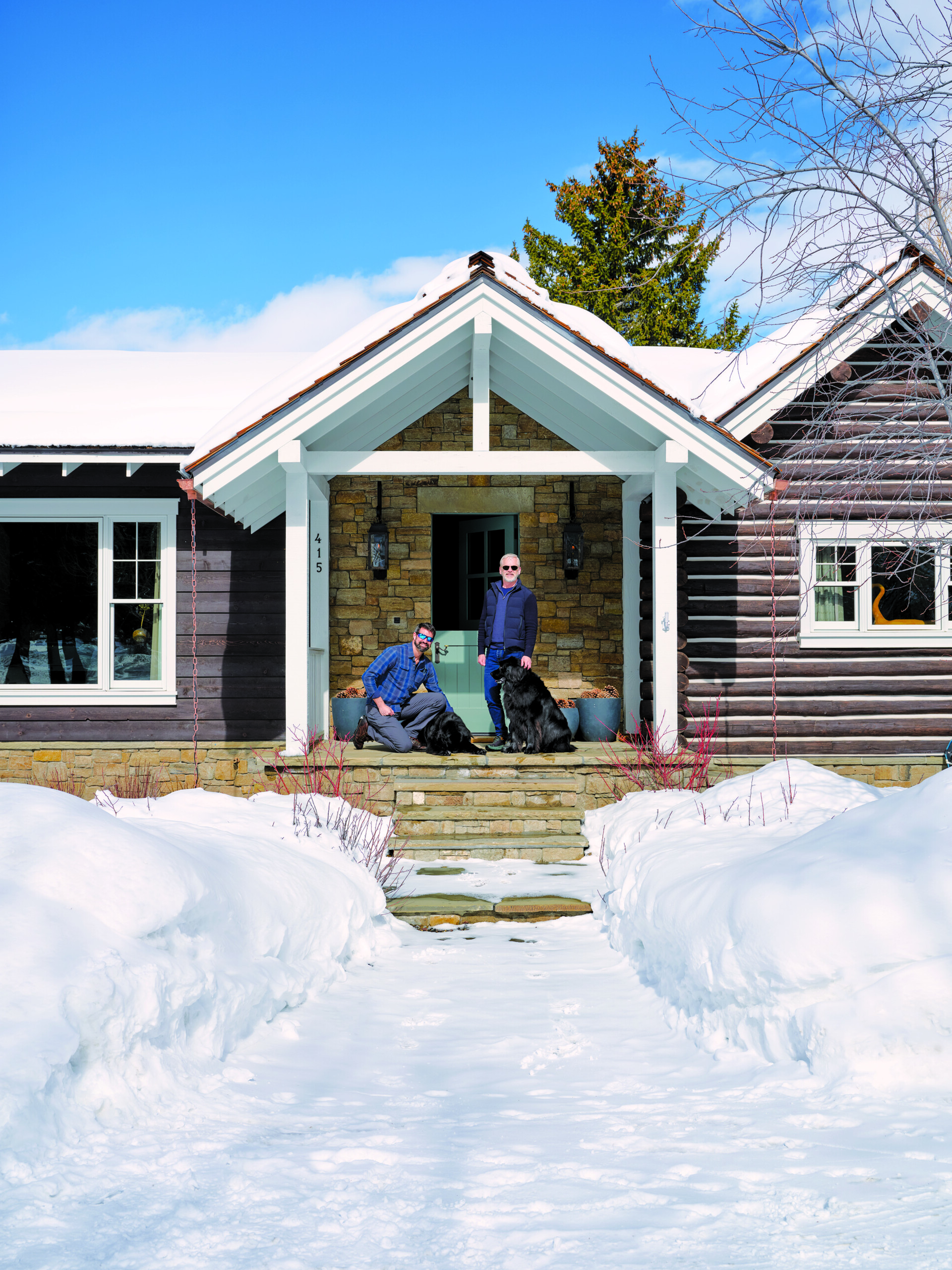
2/9: Klaus Baer (left) and Rush Jenkins enjoy a sunny afternoon with their Newfoundlands, Dutchie and Wolfie. Relocated from the village of Moran in the 1950s, the historic log cabin was uncovered during the remodel. | Photo Roger Davies
When the two were in New York (Baer working in banking and Jenkins at Sotheby’s), it wasn’t evident that they would eventually “go rural.” But, says Jenkins, “The mountains really resonate in our hearts and souls. Klaus’ heritage is part Austrian; his father lives in Innsbruck and he has a real connection to skiing and hiking. My mother’s family were Idaho cattle ranchers; my father’s were farmers. Ultimately, we felt like we should go where our hearts were.”
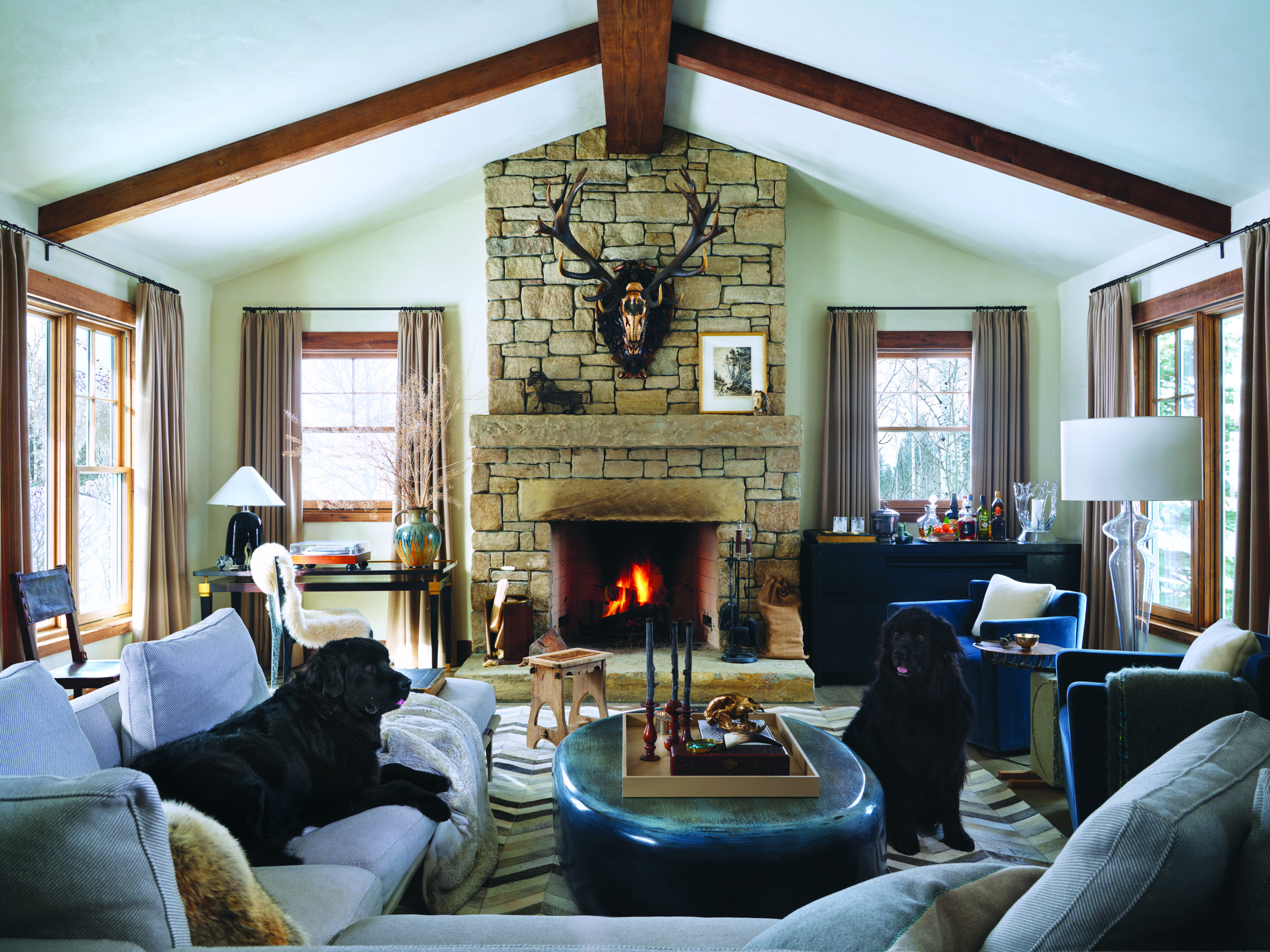
3/9: The home is furnished with the old (the 1890 stag mount belonged to Kaiser Wilhelm II), new (Poltrona Frau sofa, Holly Hunt table, Jiun Ho chairs), and meaningful. The turntable was a gift from Baer to Jenkins, to play his collection of 1960s LPs. | Photo Roger Davies
The pair’s complementary skills have meshed perfectly in running their renowned firm WRJ Design (which Jenkins founded in 2003; Baer joined as business partner in 2008) and in creating a life. Their first home in the area was in Idaho, but when they found a midcentury ranch house near the National Elk Refuge with room to indulge their gardening passion, they jumped.
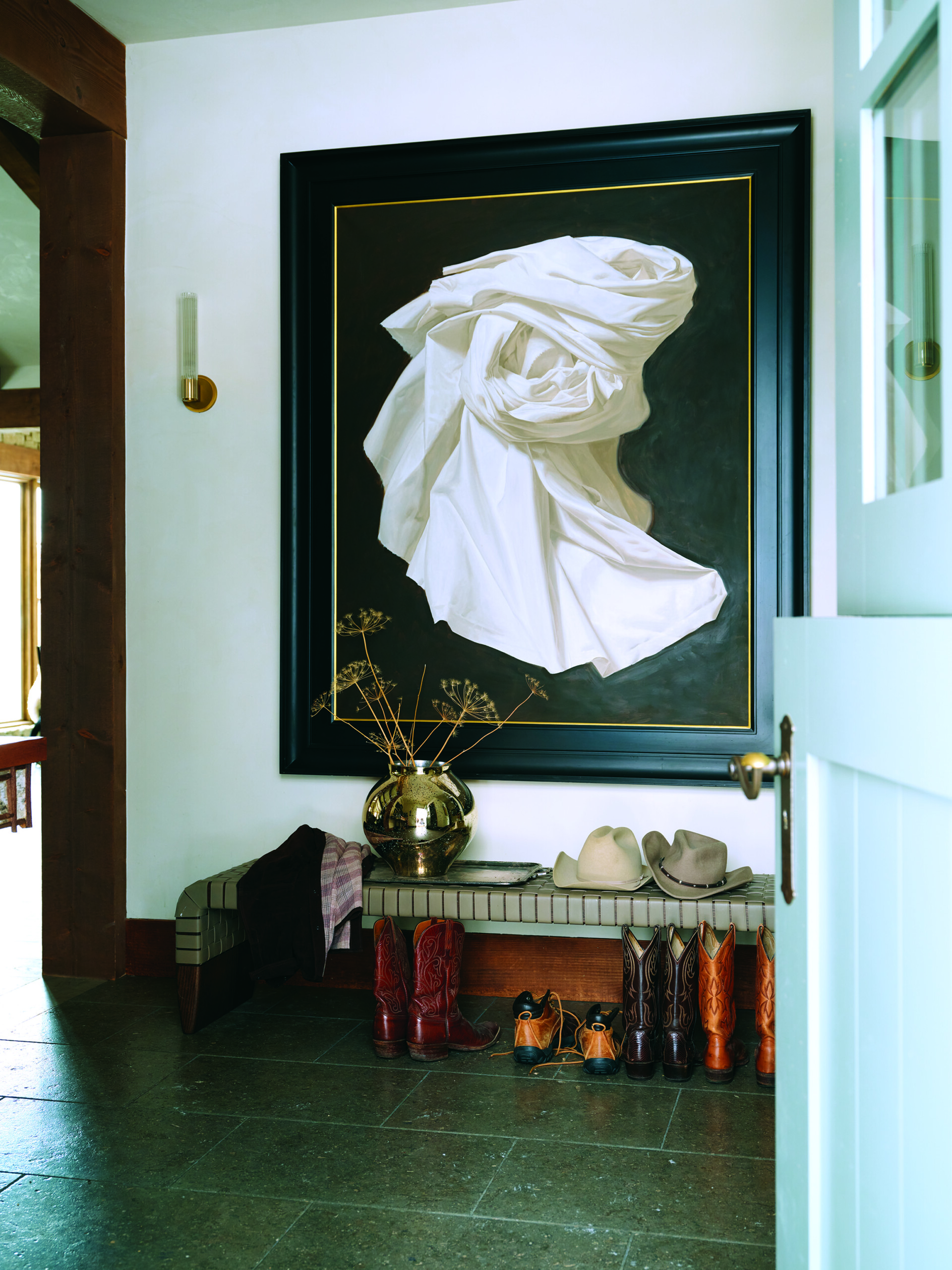
4/9: First impressions in the new entry: Daniel Adel’s painting hangs above a Poltrona Frau bench with leather strapping. The hats belonged to Jenkins’ father. | Photo Roger Davies
For five years they lived in the house as it was. Then one Saturday during the pandemic a leak sprang up in the basement. They’d wanted to renovate the basement and were considering redoing the kitchen. Soon they’d hired architect Shawn Ankeny and completely gutted the building.During the demolition they made an exciting discovery. “When they built this house in the 1950s,” explains Jenkins, “the county was getting ready to flood the lake in Jackson. All the cabins around the lake in Moran had to be removed. The people who owned this house took one of these cabins and attached it to their house. Then they vinyled over it.”
The newly unveiled log cabin became the primary suite; the rest of the project unfolded organically. The kitchen, Baer’s domain, received a contemporary makeover with lacquer cabinets and Taj Mahal quartzite countertops. “This kitchen was a bit of an experiment for us, but we love it,” he says. “It’s not big but it’s very efficient, with upper cabinets that open up instead of sideways and a big window that opens like a garage door so you can serve people on the covered patio.”
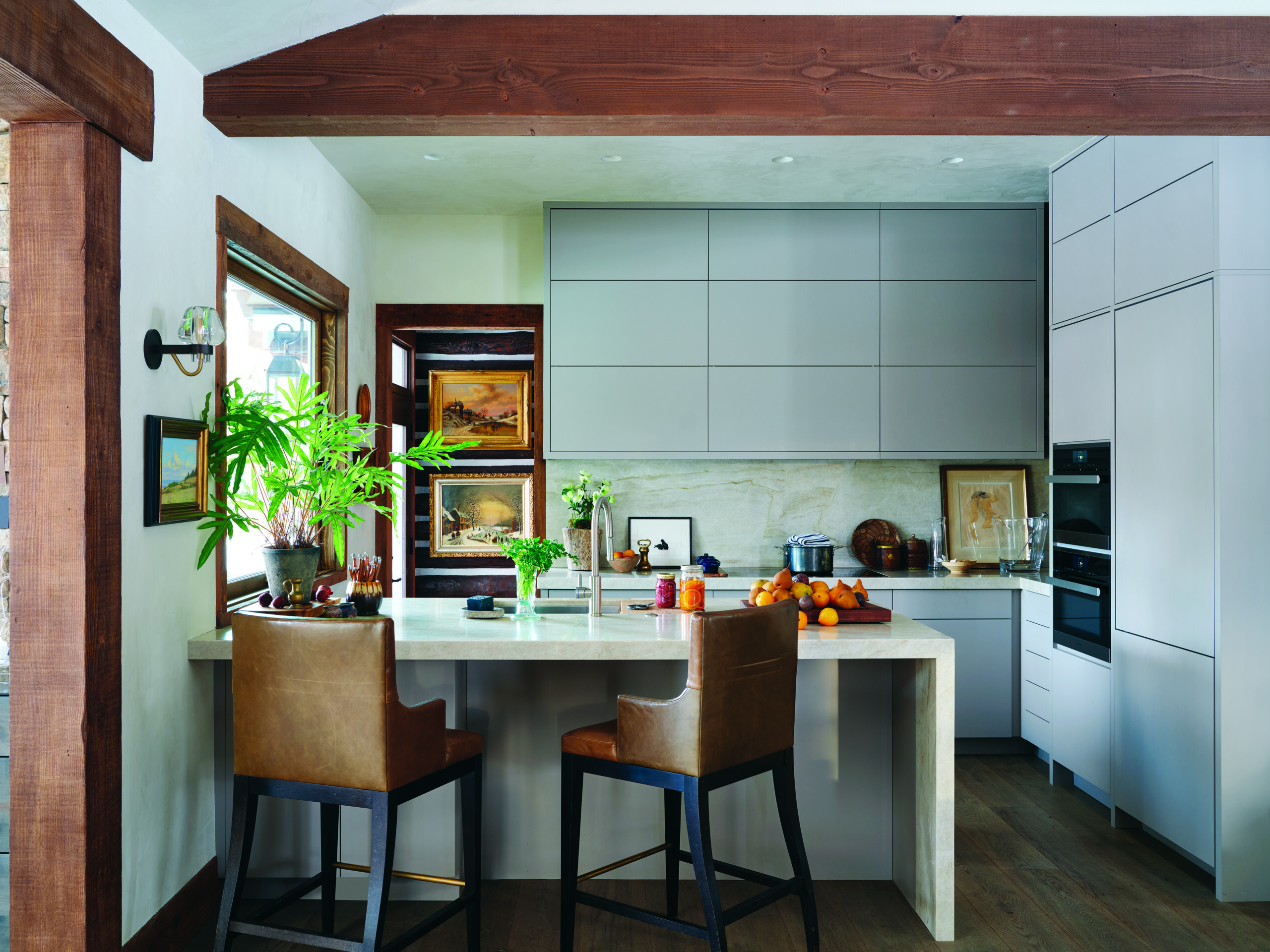
5/9: Baer does the cooking in this compact, art-filled kitchen. The stools are Bolier, the sconces Jonathan Browning, the cabinets Earth Elements. | Photo Roger Davies
A dining space of stone and timber was added to project into the garden, an experience heightened by glass walls on three sides. The lower level houses a guest suite featuring Phillip Jeffries wool wallpaper and a marble-detailed bath. The addition of a formal entry creates a sense of arrival, while a heated covered porch is a favorite place for Newfoundlands Wolfie and Dutchie to watch for the wildlife in the backyard.
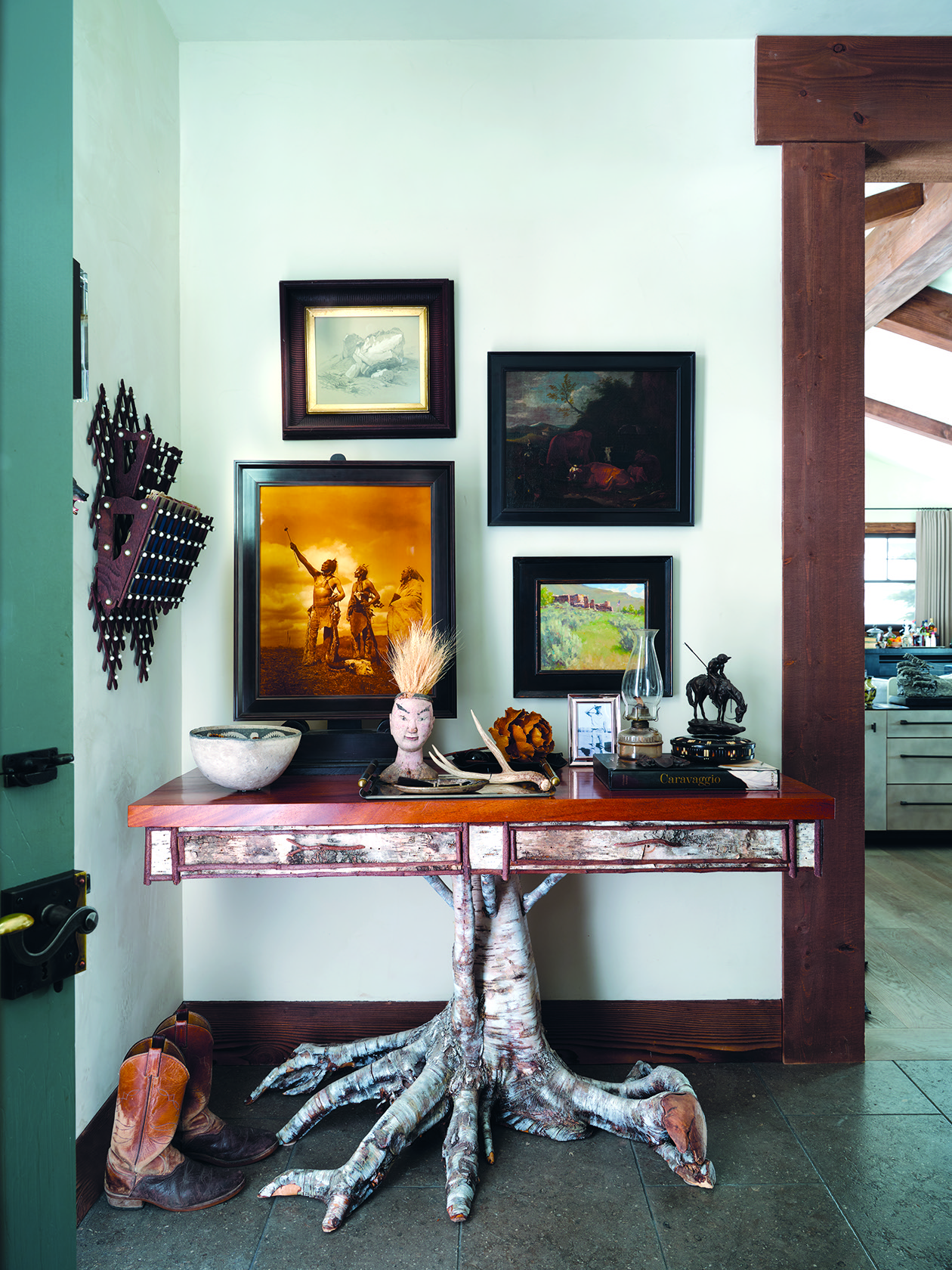
6/9: A living room vignette combines an antique Adirondacks-style console, a tramp-art letter holder, a lantern that belonged to Jenkins’ great-grandfather, an Edward S. Curtis photograph and Jenkins’ father’s cowboy boots. | Photo Roger Davies
What’s most striking about the interior is its balance of welcome and comfort with elegance and modernity, and the way it so successfully combines art and collectibles of varied periods, locales and decorative styles. An Edward S. Curtis photograph, a vintage Steinway, a turntable and stack of LPs, a Baker Furniture desk designed by French architect André Arbus, Jenkins’ great-grand- father’s kerosene lantern—all live together, arranged in a way that never feels overcrowded or frenetic. Each space is filled with unique, memory-holding pieces—including an 1883 antler mount that belonged to Kaiser Wilhelm II—and anchored by contemporary furniture from Holly Hunt, Poltrona Frau and Jiun Ho.
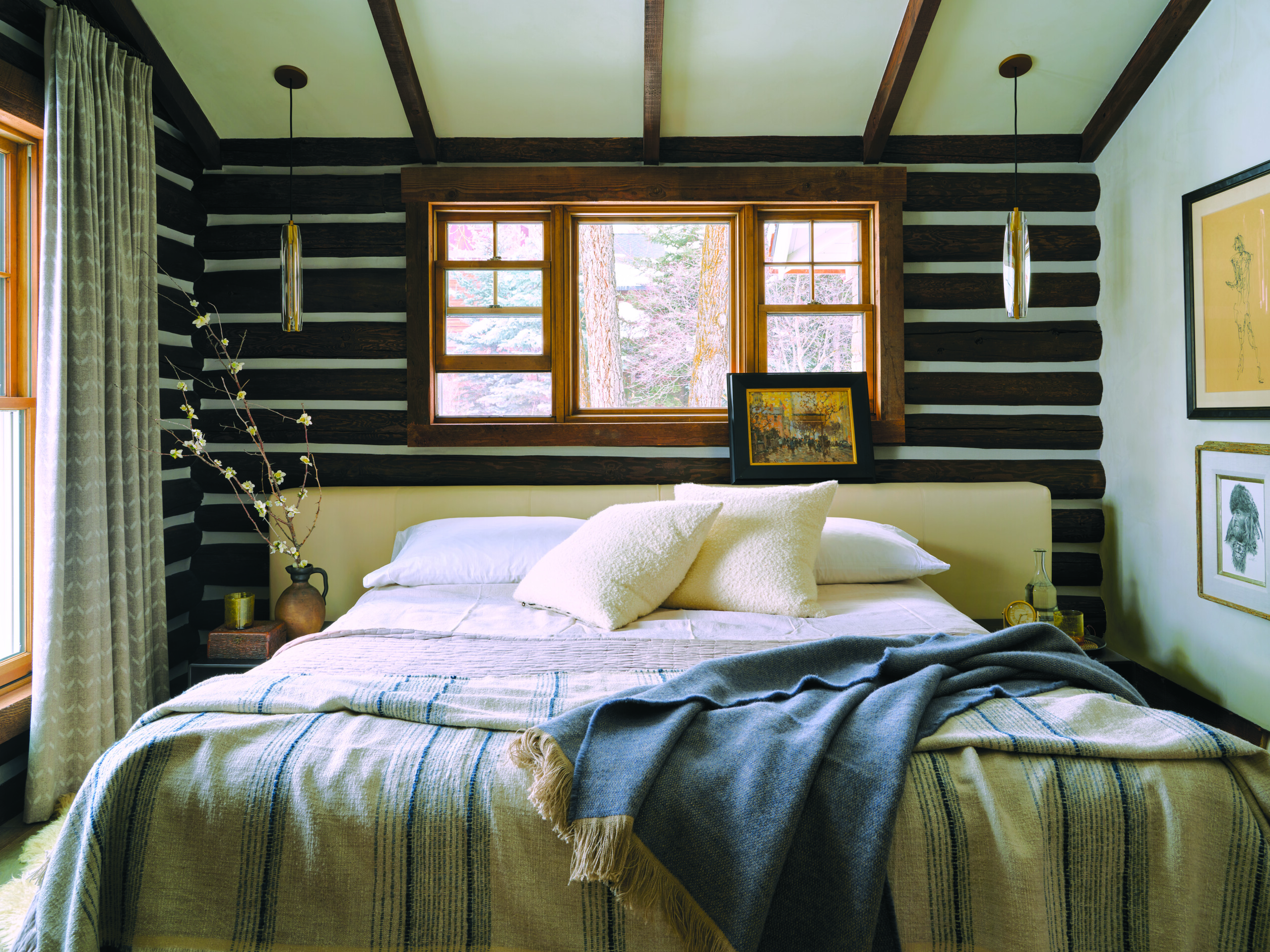
7/9: A Molteni bed with Holly Hunt leather is flanked by Jonathan Browning pendants. | Photo Roger Davies
While the inside of the home is all about storytelling, its exterior of board, log, stone and white trim fits seamlessly into the neighborhood. The once vinyl-clad ranch house now presents as a charming bungalow possessing a Western sensibility with a nod to the Cotswolds. “A lot of historic structures around Old Town Jackson have dark wood painted chocolate with white trim,” explains Jenkins. “We carried that aesthetic to the new part, then [revealed] the cabin and added a stone garage. We wanted to honor the existing house and neighborhood, preserve green space and have gardens. It’s about trying to make the house look like it’s been there a long time, and having a beautifully designed home with authenticity of materials and place.”
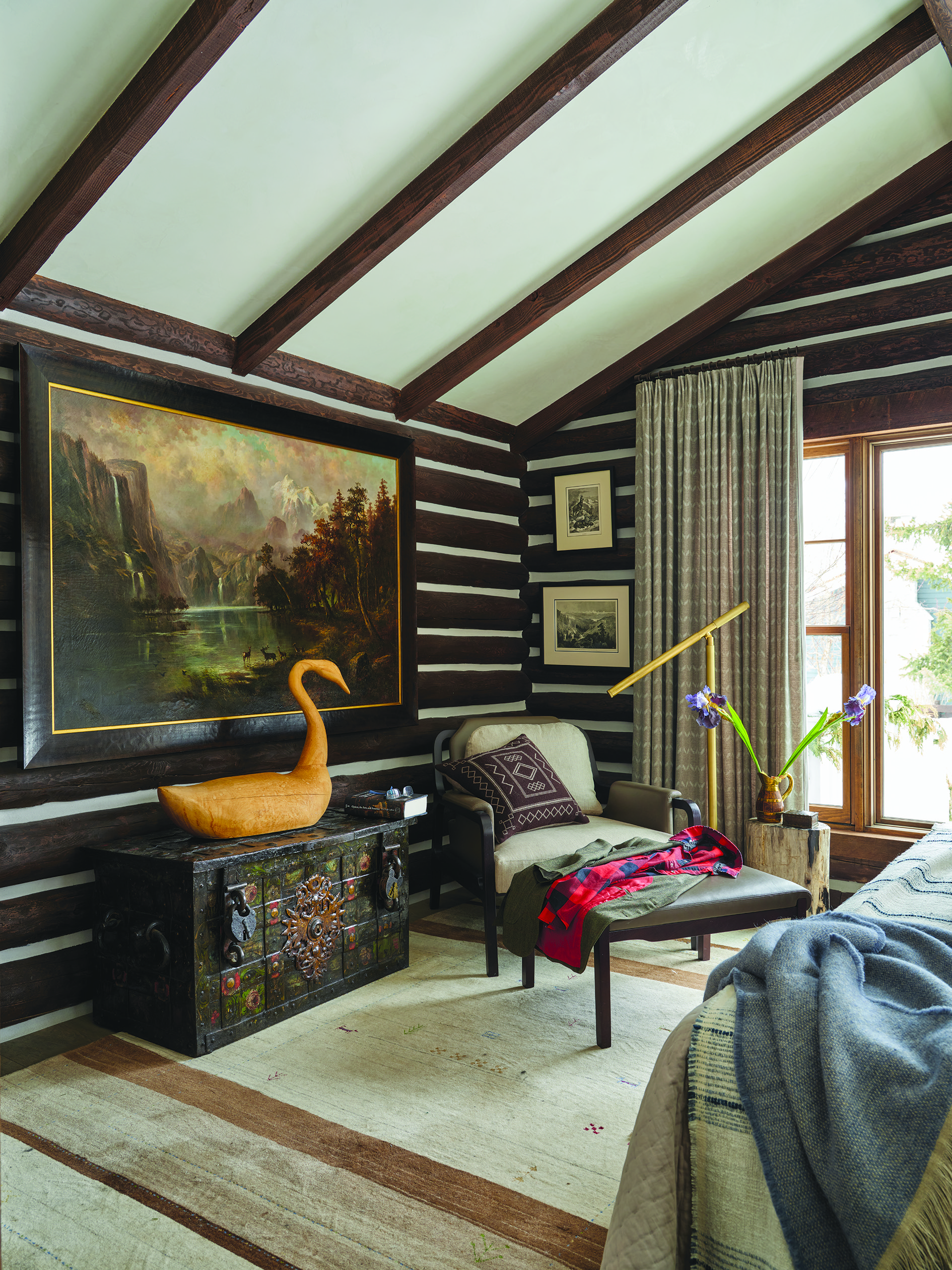
8/9: The painting is late 19th-century Bierstadt School; the prints are by Thomas Moran. A 1690 German strongbox rests atop a rug Jenkins and Baer purchased while traveling in Cappadocia. | Photo Roger Davies
Layers of Living
There’s a fine line between significant objects beautifully displayed and overwhelm. Rush Jenkins and Klaus Baer are masters of the medium, as seen in their richly layered— but never cluttered—Wyoming bungalow. Here’s how they approach the task of choosing what and how to display disparate items from a well-lived life:
Personal meaning is first and foremost in what we choose to display. When working with clients, it should be those things that resonate most deeply with them. Focus on the items that bring you pleasure whenever you see them, and maybe have that tactile element that invites you to reach out and touch. In grouping items, we like to choose pieces within the interior palette—in our case, typically connecting to colors found in the natural surroundings. Then we might add pieces of different textures and ages to create depth.
We particularly like to introduce natural and found objects, such as a beautiful branch with spring blossoms or fall berries, that tie to the home’s setting to reinforce sense of place. Often these elements are seasonal and temporary but heighten that connection to surrounding nature. Sometimes you have to know when to hold back. Highlighting a single object, or just a few, creates more impact. Limit yourself to those things that reflect the best quality or hold the most meaning. Trust your instincts. Some things just feel like they belong together, and it can be fun to experiment!
PHOTOS – ROGER DAVIES
INTERIOR DESIGN – WRJ DESIGN
ARCHITECTURE – ANKENY ARCHITECTURE AND DESIGN
BUILDER – JACKSON CONTRACTORS
RESOURCES
Photo 2
Dutch door
Gas Lanterns: Bevolo
Historic Cabin/Right:
– Brought from the village of Moran in the 1950’s
– Worker’s cabin, Jackson Dam construction
– Historic significance
Dogs: Dutchie and Wolfie, Newfoundlands
Photo 3
Stag Mount: Nuremburg, Ger.1890. Collection of Kaiser Wilhelm 2nd
Wire Bull/Mantle: purchased at Blackmun Cruz
Etching/Mantle: purchased upstate Maine,
Desk: designs of Andre Arbus from 1940s.
Desk Lamp: Carlo Moretti
Sofa: Poltrona Frau, leather and linen
Coffee Table: Holly Hunt
Bronze Cast of Bear Skull: by artist Ashely Tudor
Blue Velvet Side Chairs: Jiun Ho
Side Table: Carpenter’s Workshop,
Floor Lamp: Poltrona Frau,
Drapes: Loro Piana Cashmere
Turntable: gift to Rush from Klaus; to play vintage collection of LPs from 1960’s
TV Cabinet: custom, steel
Rug: Cowhide
Mantle stone: from Montana, Muddy Creek
– Various antiques throughout
Photo 4
Hats: Rush’s Father’s, deep sentimental value
Bench: Poltrona Frau, leather strapping
Hardware: White Chapel
Sconce: Jonathan Browning
Painting:
– First painting purchased together, in NYC
– Gallery: Arcadia Gallery
– Artist: Daniel Adel
Photo 5
Stools: Bolier
Cabinets: Earth Elements
Appliances: Miele
Countertops/Backsplash: honed Taj Mahal Quartzite
Sconces: Jonathon Browning
Paintings on Log Cabin: from the collection of Dick Button
Drawing on Counter, Right: from School of Rodin
Painting Under Sconce: local artist Bart Walker
Photo 6
Console: antique Birch, acquired at auction years ago, Adirondacks-inspired
Photo of Indians: Edward S. Curtis
Letter Holder/Wall: purchased at antique dealer; Early 20th c. Tramp Art
Indian Wheat Head: from collection of Barbara Streisand, Julien’s Auctions
Metal box: purchased Sag harbor
Lantern: belonged to Rush’s great grandfather, from cabin on family ranch
Indian on Horse Sculpture: part of Rush’s father collection, gift to Rush from his father
Painting, bottom right: portrait of Wildlife Museum, Jackson.
Other Art: Various artists
Boots: belonged to Rush’s father
Photo 7
Bed: Molteni, with Holly Hunt leather
Pendants: Jonathan Browning
Painting (top): From Klaus’ first collection of paintings
Historic Cabin:
– Brought from the village of Moran in the 1950’s
– Worker’s cabin, Jackson Lake Dam
– Historic significance
Photo 8
Painting: Bierstadt School, last quarter 19th century
Prints: By Thomas Moran, late 1800’s
Strong Box: Nuremburg, Ger. c. 1690
Swan: from collection of Geoffrey Beene, Sotheby’s Exhibition
Chair/Ottoman: Castelle
Rug: From village of Cappadocia, Turkey; purchased by Rush and Klaus while traveling
Pillow: Loro Piana
Drapes: Loro Piana cashmere
Photo 9
Painting: Of Dutchie and Wolfie, by local artist Nicola Hicks, Tayloe Piggott gallery
As featured in ML’s January/February 2024 Issue

